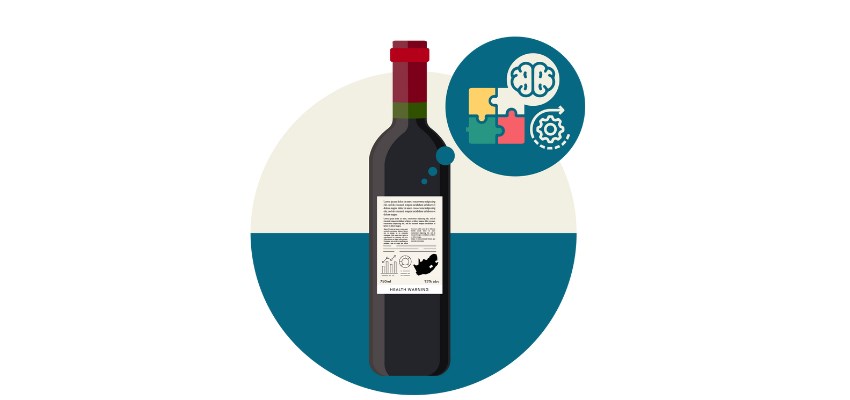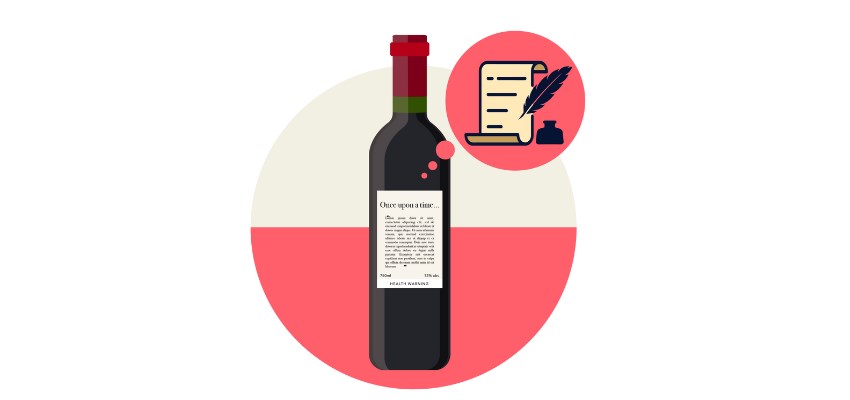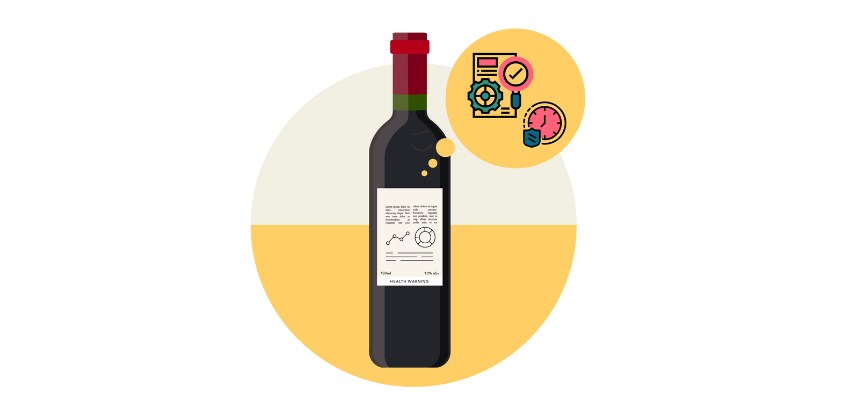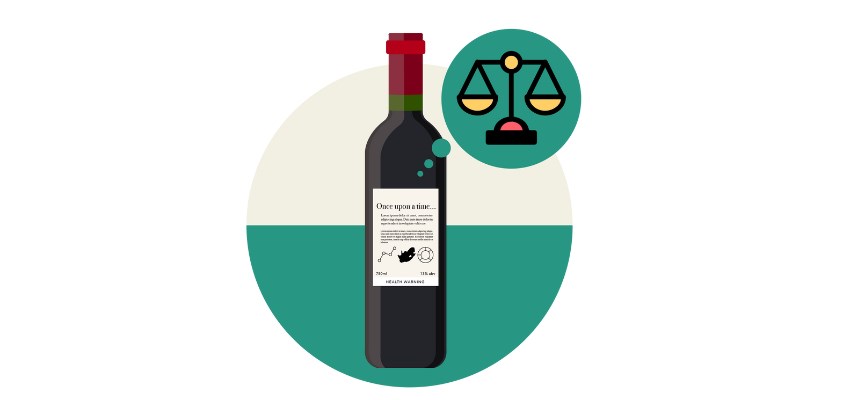To continue the previous metaphor, where we compared the front label of a wine to the front cover of a book (deemed worthy of judgement), it should be safe to agree that the back label is tantamount to a tome’s back cover.
As before, let’s start with my deep and shameful confessions: I very, very rarely read back labels. I prefer hunting for technical sheets where my ageing eyes get relief from a zoomable font size, and where the luxurious spacing pleases my designer brain. It’s a habit that has stemmed from the lack of consistency in the information that’s relayed on back labels.
As with characters in a holiday novel, back labels span the range of stereotypical caricatures. Let’s investigate some character development besties who surround our protagonist (the wine):
Back label personalities

Type C: The detail-oriented, energetic, overthinking, daily planner toting friend who leaves nothing to chance. They find room to suggest optimal serving temperatures and food pairings alongside soil types, winemaking techniques, barrel ages, and a neat summary of the tasting notes.

Type B: The social and whimsical storyteller who weaves together history and inspiration to tug on our heartstrings with feelings… Feelings that don’t offer much in the way of practical information.

Type D: Dependable, accurate, risk averse best friend who always gets the job done. They always suggest sound, practical advice but tend to keep their feelings to themselves.

Type X: The well-rounded friend that has a combination of all the above, and the one you’ll most see as they offer something for everyone.
You’re wondering ‘who is Type A? Who is the narrator that provides a cohesive voice that carries the storyline? SAWIS!
Uniformity around the world?
The lack of uniformity is global. Amusingly, I’ve spent more time deciphering international labels…where English is not always the default language. I am uncomfortably aware of my monolingualism (much to the dismay of my bilingual parents who have a knack for languages). Here’s a speed read through some of the titles on my shelf:
Australia and New Zealand do well. I’ve often thought that Australia is rather similar to us, just with more grape varieties and a larger proportion of very old vines (100+ years puts 35 years into context).
France has plenty of Old World arrogance that insists that your brain remember which grapes belong to which region. However, my, possibly more eclectic, shelf holds a surprising number of grape names; along with the contact details, and some indication of elevage, all in French…monolingualism – merde!
Germany feels more like efficiency than arrogance – and I support this level of consistent detail. Also, I’m prepared to accept anything that wraps around outstanding Riesling.
‘Eastern Europe’ seems to favour cold hard facts over poetry. Despite their often long histories of wine production, they’re still new to the rest of the world. Perhaps proving their viticultural and vinicultural chops is both an assumed stereotype as well as a more productive way of ensuring international respect.
Italy is fairly comprehensive. Even the funky natural orange wines hold a fair amount of detail. But as the largest wine exporting country, it’s bemusing that so many bottles are solely in Italian.
There is NO consistency around the world. It is partly understandable as we’re different countries with different labelling laws. But we’re all exporting wines – well, almost all – I’m looking at you, Switzerland.
Is anyone reading back labels?
A few of us are partial to very old vintages. I asked a few friends in the USA, Australia, and South Africa, and they’ve also noticed that a large proportion of old labels (pre to early 70s is what we’ve are most notable) do not have any back labels. Common sense says that labelling regulations must have played a role in the mass adoption of these additional labels with their extra production costs.
Between the “class designation, alcohol content, full name and address or A code number of the responsible seller, the origin appellation or the name of the geographical unit, barcode, health warning, sulphite labelling, ABV, and volume…that’s a lot of information to absorb along with the story and taste profile. It is interesting that not many studies have investigated how consumers interact with back labels.
One of the frequently cited back label studies was run in Australia in 1999, titled 'Consumer responses to wine bottle back labels'. A roughly evenly split group of men (51.8%) and women (46.4%), 66% of them under the age of 35 and all generally knowledgeable about wine, were asked to provide feedback on 3 Chenin Blancs and 3 Shirazes.
- Interestingly, one participant could not even match the three white wine label flavour descriptions to the correct colour wines tasted.
- In fact, 73% of the group accurately matched only three or fewer wines to the label descriptions. Only one person matched all six.
- 28% of participants claimed to have had wine tasting training and 30% had no training - both the trained and untrained matched four or more wines to their back label descriptions.
- Women were more likely to read back labels in the store (61%).
The study concluded that:
- consumers do use back labels, albeit only one element of several strategies, when making purchasing decisions.
- Aroma and flavour descriptions, despite not always successfully matched in this study, are what participants felt to be the most useful.
- And, unsurprisingly, that there is a large degree of variability in the way people respond to wine labels.
Another study, 'The importance of wine label information', using a 7-point scale (7 being of great importance, 1 being of little importance) found that, when it comes to purchasing decisions, front labels (4.79) are only marginally more important than the back labels (4.60).
And the last study (I promise): in 2015, Penn State researchers and a faculty member from the University of South Australia found that:
- The ‘winning label combinations’ amongst their study participants included wine and food pairing suggestions (either written or using symbols), contact information (email and website); and winery background information (winery, wine region and winemaker).
- QR codes and tear away strips were duds.
- Information about only the winery or information about only the wine region were both negatively received - consumers wanted both. Label personality Type X!
One thing that most label studies acknowledge is that consumers are varied and those with more wine knowledge prefer technical detail and less fluff. But dammit, I love a good story! - as do lower involvement consumers who may also choose wines based on pairing suggestions and ‘fruity’ or ‘opulent’ descriptions.
Do back labels matter or are they largely legal requirements?
Ever the time-wasting prankster, I’d had a fleeting thought that it would be amusing to display wines with their back labels facing the consumer. Because this is where you’ll see some of the good that some wineries do: sustainability measures, environmental consciousness, community support, wildlife support.
I struggle to make peace with the monoculture nature of most vineyards. Seeing the words and logos that show that a winery does more than just make wine for profit; those are the back labels that hold the most meaning to me and make rotating the bottle worth the effort. There are brands who display their Fairtrade labelling on the front of the bottle and, together with the Integrity & Sustainability labels, are accreditations and actions that South Africa should be very proud of initiating (Integrity & Sustainability) and being the world’s largest producer of (Fairtrade).
Epilogue
At the end of the day, one has to marvel at how much (or little) information can fit on what is essentially the size of a Post-It. I am curious as to how consumers would react if nutritional information and a list of additives were included. Should all wine labels not include braille - especially those already embossed? Will we see more producers adopt the environmentally friendlier and price friendlier wraparound labels? Can SAWIS ever accept no label, and allow digital natives to reduce carbon emissions? Will someone please one day fight for the right to display all the information in one of the official South African languages…not only English (I learned the hard way that the health warning has to be in English)? And I hope there’ll come a day where we will all rotate each bottle in eager anticipation of seeing how the winery is more environmentally and socially responsible.
PS: Let’s wrap up this analogy - because both you, and I, deserve better. Yes, in this analogous world, the box would be the dust cover. The wine shelf has always been the bookshelf. The corkscrew and stemware are the reading glasses that some of us need. The decanter is the increasingly useful reading lamp that helps some of us see better. And I do believe that the cork is the perfect bookmark - the pause before eagerly returning to where you left off. We’re done…next metaphor!